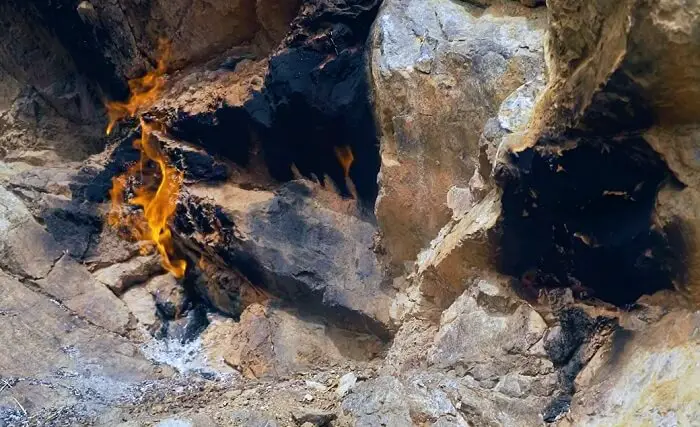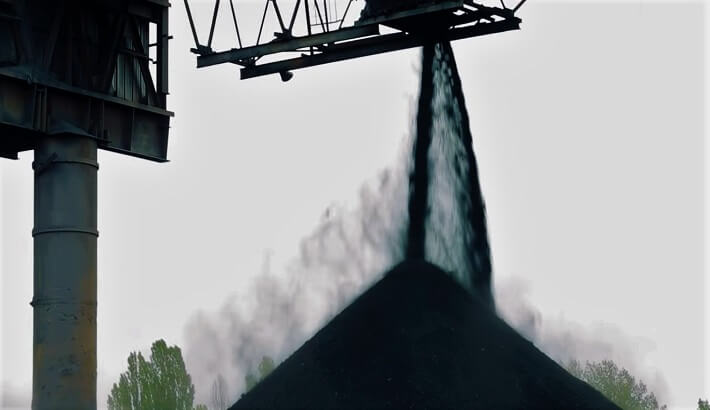Note: This article may contain affiliate links, which means if you make a purchase following our links won’t cost you extra, but we may earn a commission. Learn more
Natural gas is a non-renewable energy source because it is derived from fossil fuels. Fossil fuels are formed over millions of years from the remains of plants and animals, and they are not replenished on a human time scale. Natural gas is mostly methane, which is a hydrocarbon gas that forms when organic matter decomposes in the absence of oxygen.
Methane can be used as a fuel for cooking, heating, and generating electricity. It is also an important component of natural gas pipelines.
Natural gas is an important energy source for many countries, but its use comes with environmental concerns.

Natural Gas
Natural gas is a fossil fuel formed when layers of buried plants and animals are exposed to intense heat and pressure over millions of years. The energy that the plants originally obtained from the sun is stored in the form of carbon bonds within the natural gas. Natural gas is composed of mostly methane, but can also include small amounts of other hydrocarbons like ethane, propane, and butane.
It is often found alongside oil deposits and is extracted using similar methods. Once natural gas has been extracted, it must be purified to remove any impurities like water vapor, carbon dioxide, or hydrogen sulfide before it can be used. Natural gas is most commonly used as a fuel for combustion in order to generate electricity or heat.
It is also used in some industrial processes and as a raw material in the production of chemicals like ammonia, methanol, and hydrogen. Natural gas burns cleaner than other fossil fuels like coal and oil, making it an attractive option for power generation.
Where Does Natural Gas Come from?
Natural gas is a fossil fuel that forms when layers of buried plants and animals are exposed to intense heat and pressure over millions of years. The energy that the plants originally obtained from the sun is stored in the form of carbon. Natural gas is composed mostly of methane, which is a molecule consisting of one carbon atom and four hydrogen atoms.
Methane can be found in many different places including swamps, landfills, and coal beds. However, the majority of natural gas comes from underground reservoirs. These reservoirs can be either depleted oil fields or purpose-built storage facilities.
The natural gas that we use today comes from a variety of sources all over the world. In order to extract natural gas from underground reservoirs, wells are drilled into the rock formations where the gas is thought to be trapped. Once a well has been drilled, a steel pipe (casing) is inserted into the hole to protect the wellbore from collapsing.
Next, perforations are made in the casing so that natural gas can flow up through the wellbore and into the production tubing. Finally, a series of valves called a Christmas tree is installed on top of the wellhead to control the flow of natural gas. Once natural gas has been extracted from underground reservoirs, it must undergo processing to remove impurities such as water vapor, carbon dioxide, nitrogen, hydrogen sulfide, and mercury.
After processing, natural gas is transported via pipelines to power plants or industrial facilities where it will be used as fuel or converted into other products such as propane or fertilizer.

How is Natural Gas Formed?
Natural gas is a fossil fuel that is formed when layers of buried plants and animals are exposed to intense heat and pressure over millions of years. The organic matter transforms into a gas composed of methane and other hydrocarbons.The majority of natural gas deposits in the United States were formed during the Mesozoic Era, between 245 and 66 million years ago.
This was a time when the world was much warmer than it is today, allowing for lush vegetation to grow across vast areas. As these plants died, they fell into swamps and were gradually covered by sediment.Over time, the heat and pressure from the sediments caused the organic matter to change into natural gas.
This process is known as coalification, and it typically takes place at depths of around 3,000 feet (900 meters).Today, natural gas is extracted from underground reservoirs using drilling techniques like fracking. Once the gas is brought to the surface, it can be used for a variety of purposes including electricity generation, heating homes, and powering industrial facilities.
Why is Natural Gas Considered a Non-Renewable Energy Resource?
Most people think of natural gas as a clean and renewable energy source. After all, it’s far cleaner than burning coal or oil, and it’s derived from organic matter underground. However, natural gas is actually a non-renewable resource.
Here’s why:
Natural gas is formed over the course of millions of years from the decomposition of organic matter like plants and animals. This process is incredibly slow, meaning that the amount of natural gas in the world is finite.
Additionally, we are extracting and using natural gas faster than it can be replenished. In other words, we are consuming this non-renewable resource at an unsustainable rate. So why do we continue to use natural gas?
For one, it’s cheap and abundant – at least for now. It’s also relatively clean-burning compared to other fossil fuels like coal and oil. But make no mistake: natural gas is a non-renewable resource that will one day be depleted if we don’t find sustainable alternatives.
We must invest in renewable energy sources like wind and solar power if we want to ensure a bright future for our planet – and ourselves.
What are the Environmentally Friendly Alternatives to Natural Gas
Electricity is the most environmentally friendly alternative to natural gas. It produces no emissions and has a very low environmental impact. Wind, solar, and hydroelectric power are all forms of renewable energy that can be used to generate electricity.
These sources have a much lower environmental impact than natural gas.
Is Coal Renewable or Non-renewable?
Coal is a nonrenewable resource because it cannot be replenished in a short period of time. The time it takes for coal to form is estimated to be between 10,000 and 100,000 years. Coal is a fossil fuel and is formed from the remains of plants that lived and died during the Carboniferous period, which was between 360 and 286 million years ago.
Coal is classified as a sedimentary rock and is composed of carbon, hydrogen, oxygen, and nitrogen. It is a black, brittle rock that is often used as fuel. Coal is combustible and is often used to generate electricity. It is the most carbon-intensive fossil fuel and is a major contributor to climate change.
There are two types of coal: thermal coal and metallurgical coal. Thermal coal is used for power generation and is the type of coal that is most damaging to the environment. Metallurgical coal is used for steel production and is of a higher quality than thermal coal.
Coal is a nonrenewable resource and its use has a number of negative impacts on the environment. These include air pollution, water pollution, and land degradation. Coal mining can also have a negative impact on local communities and the people who live in them.
Despite the negative impacts of coal, it is still a major source of energy for many countries.

Is Nuclear Energy Renewable?
Nuclear energy is not renewable. Nuclear power plants generate electricity by using uranium, which is a non-renewable resource. Once the uranium is used up, the nuclear power plant must be shut down.
The Bottom Line
Natural gas is a non-renewable energy source because it is finite. There is a set amount of natural gas in the Earth’s crust, and once it is used up, it cannot be replenished. Natural gas is formed over millions of years by the decomposition of organic matter, such as plants and animals.
This process takes an extremely long time, meaning that the supply of natural gas is limited. Additionally, natural gas is often extracted from underground reserves using drilling and fracking methods that can damage the environment. For these reasons, natural gas is not considered a sustainable energy source.